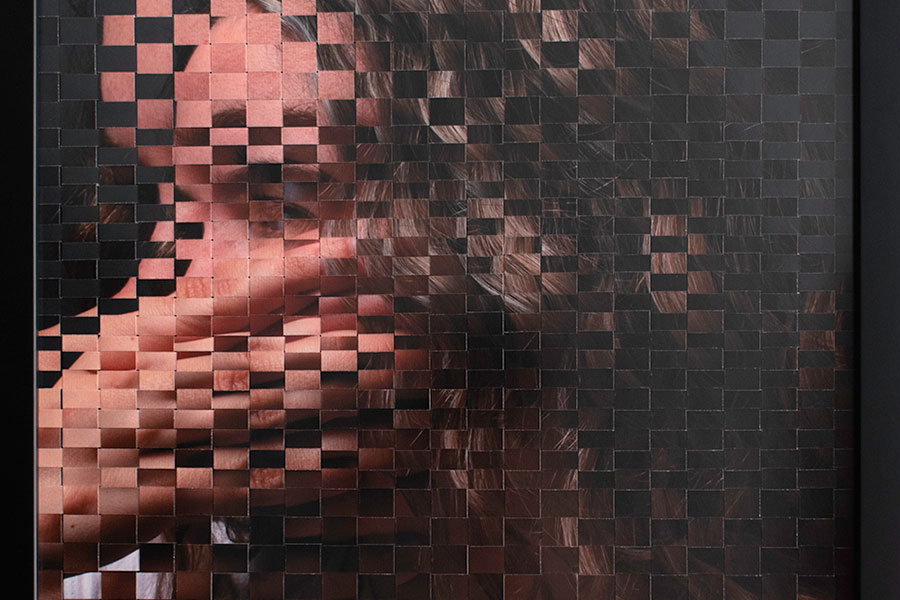Allie Garnai, photography
Thesis Title: Freothuwebbe
Dimensions: 13” x 13”
Medium: Woven archival inkjet print
 Bio: My name is Allie Garnai and I am from Wilmington, Ohio. I will be receiving a BA in studio art with a minor in education from Wittenberg University in May, 2020. After college, I plan to pursue a career in art education. I am a recipient of the Paul and Clara Weaver Endowed Scholarship (2018) and the Wittenberg Guild Fine Arts Scholarship (2020) for my work within the art department. In my spare time, I enjoy choreographing and performing in dance concerts at Wittenberg University. I am also the cofounder and president of the WittKnits Fiber Club. My artwork uses photography to explore the body, motion, and craft.
Bio: My name is Allie Garnai and I am from Wilmington, Ohio. I will be receiving a BA in studio art with a minor in education from Wittenberg University in May, 2020. After college, I plan to pursue a career in art education. I am a recipient of the Paul and Clara Weaver Endowed Scholarship (2018) and the Wittenberg Guild Fine Arts Scholarship (2020) for my work within the art department. In my spare time, I enjoy choreographing and performing in dance concerts at Wittenberg University. I am also the cofounder and president of the WittKnits Fiber Club. My artwork uses photography to explore the body, motion, and craft.
Artist’s Statement: My thesis project, Freothuwebbe, explores the intention of handwork through the process of weaving photographic images together. The two photographs that become woven portray the same model in similar poses but differing in scale. All photographs in this work incorporate the subjects’ bodies being manipulated by their hands. I chose rice paper as my printing medium because it is a lightweight, fibrous material that allows me to manipulate the printed photographs. I was intentional with each image in what details I wanted woven and left unobstructed. In some weavings, such as “Freothuwebbe 03”, I kept the width of the strips for the warp (strips going up and down) consistent and then wove into them a variety of width dimensions for the weft. Through this technique I was able to allow important details of the model to be seen, such as the three hands and her rings in the top part of the image. The strips for the photograph with the larger scale were cut horizontally for the weft so that with a smaller width of strip, a viewer is able to see more detail of the hand over a bigger surface area. In other works I decided to leave areas of the weaving unwoven and uncut, such as “Freothuwebbe 02” where the models arms are crossing each other on a diagonal but the arm on the right side is left untouched. This allows for the viewer’s eye to find a resting place on the image before looking closer at the detail.
Click Here To View Photo Gallery
The lasting effect of the weavings are pixelated images of bodies. Through the technique of weaving, I have created an image in which the subject is not fully seen. At the same time, the weavings exhibit duality through the two photographs working together. In “Freothuwebbe 04” the trunk of the model’s neck is cut vertically so that the photograph of the face is woven as the weft. The area a viewer’s eye focuses on is the overlapping of the two photographs. Through weaving, they are dependent on one another to create the meaning of the full image.
The body of work is titled Freothuwebbe, which is a word derived from Old English meaning “peaceweaver”. The term describes a woman who marries a member of a rival or enemy tribe in the effort to obtain peace among the two tribes. I am fascinated by the concept of a woman creating peace through the unity of marriage and its connection to weaving. This unique, specific role establishes power. By continuing to weave the peace among the tribes, a “peaceweaver” is deemed a well respected woman by her community. My work explores the concept of a peaceweaver through a modern lens. I chose to photograph women in their early twenties because this age group experiences an incredible amount of transformation over a short period of time. As a woman in her early twenties, I can attest that I often feel an obligation to establish an identity while at the same time still attempting to figure out my role and purpose. This juxtaposition creates a twisted idea in which you are defined by others and yourself simultaneously. In my head, I visualize this idea as a fractal image in which both concepts are presented but neither are fully seen. It is unsettling, much like the pixelated effect of the woven images in my work. The reasoning behind leaving parts of a weaving unfinished establishes the idea that the subject is unable to see both identities at the same time.
My concept for what it means to be a modern day “peaceweaver” emerges from the idea of role and power. Instead of establishing this position through a marriage contract, I am focused on the idea of weaving peace within oneself. Through the acceptance that identity can be both ideas at the same time, one can find harmony. There will always be a complexity in one’s identity. A single idea, whether decided by oneself or by others, will attempt to overpower. A successful peaceweaver through this lens is represented in my work when the entire image is woven, such as in “Freothuwebbe 03”, “Freothuwebbe 06”, and “Freothuwebbe 08”. All three works represent someone who has found a balance within oneself and accepts both forms of identity created by self and others.

